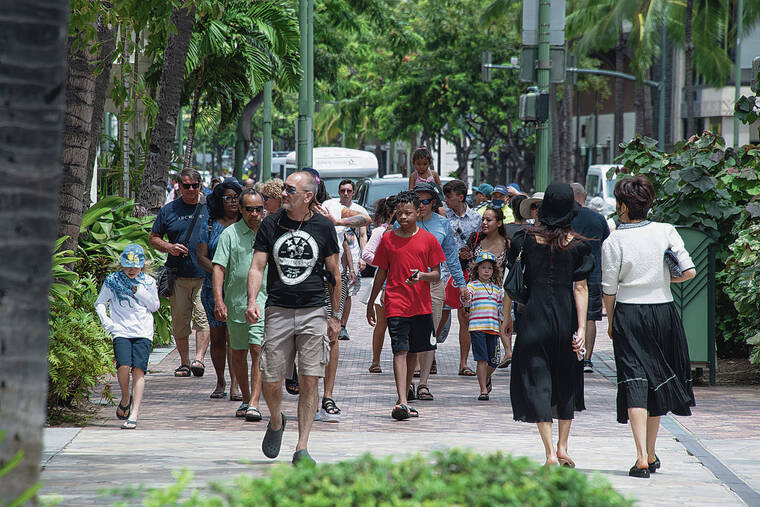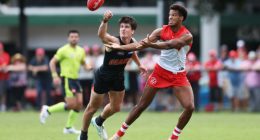
Mahalo for supporting Honolulu Star-Advertiser. Enjoy this free story!
The COVID-19 pandemic has not only affected people’s health, but also their economic security, mental well-being and ability to work.
To shed light on the pandemic’s adverse impacts across multiple dimensions beyond the direct effects of COVID-19 itself, the University of Hawaii Economic Research Organization is debuting its first quarterly public health report.
The report, “Health Effects and Views of COVID-19 in Hawaii,” takes a detailed and comprehensive look at numerous aspects of the pandemic — how it has affected people’s jobs, their ability to buy food and their mental well-being, as well as how vaccination status factors into the picture.
“It looks at a variety of impacts on public health, which obviously impacts economics,” said Ruben Juarez, an economics professor at the UH Manoa College of Social Sciences. “It’s just a start at this point. I’m hoping this will service policymakers and the community to continue the conversation with stakeholders on what strategies we need to move forward.”
The report is based on survey responses from a cohort of more than 2,000 Hawaii adults from across the state in May, when the state was in the midst of its fourth wave of COVID-19 cases, according to Juarez, also UHERO’s HMSA Endowed Professor of Health Economics.
UHERO put the cohort together in partnership with the state, and will be conducting monthly surveys following the same individuals for a long period of time.
What the report found is that the pandemic has had a significant, negative impact on much of the population — two out of every three people surveyed.
It also has caused economic hardship, with about 23% of respondents reporting that their savings were depleted due to the pandemic, while about 15% say they were unable to pay their bills, 9% lost their jobs and 8% did not have enough food for their household.
Additionally, 12.5% reported having been furloughed or having their work hours reduced.
In other aspects of life, nearly 18% reported troubles with the education of their children and 8.7% had trouble with child care.
There was also personal loss, with 12.4% reporting a close friend who died and 9.2% reporting the loss of a family member due to COVID-19.
Accessing medical care, however, did not seem to be a major concern, with only 2.6% saying they were unable to get medical care for serious problems for themselves and 3% saying they were unable to get medical care for serious problems for their family members.
The pandemic took a toll on mental health, as well, with one out of every three residents surveyed reporting some symptoms of depression. Even more alarming, 4.2% of survey respondents said they had contemplated suicide during the past year.
UHERO also found that 31.3% of respondents that tested positive for COVID were suffering from long COVID, or long-term symptoms following the infection.
The most common symptoms were cough and shortness of breath, followed by extreme fatigue, mental fog and headaches.
Of those suffering from long COVID, about half reported symptoms that were medium to severe.
This potentially affects the size of Hawaii’s workforce when many sectors of the economy are struggling from staffing shortages, said Juarez.
The report also takes a dive into the characteristics of those who remain unvaccinated, including where they get their sources of information on the pandemic, and how they are faring.
The unvaccinated tend to be younger, the report found, with a higher percentage among those in their 30s than those ages 50 and older.
Also, the higher the level of education, the more likely individuals were to be vaccinated, the survey found. Individuals with an advanced or bachelor’s degree reported very low rates of being unvaccinated, at 3% and 4%, respectively. The highest percentage of those unvaccinated, 41%, had no high school diploma.
Those who were unvaccinated tended to get more of their information from social media and faith leaders than from medical providers, government sources or the Centers for Disease Control and Prevention.
There continue to be disparities among ethnic groups, and the highest percentage of unvaccinated in the state — at 21% — are Pacific Islanders.
This could be useful for the state Health Department, said Juarez, in refining its messaging or target strategies for vaccination outreach.
Those who remain unvaccinated tended to experience greater hardship, food insecurity and depression, the survey found, likely reflecting socioeconomic disparities.
Most respondents, about 58%, saw the current impact of COVID-19 on their life as a health concern, while about 31% found it to be more of an inconvenience; 7% found it to be neither, and about 4% were unsure how it affects them.
Should there be another large COVID-19 wave, the majority of respondents, 92%, expressed a willingness to wear a mask in indoor public spaces.
In a separate question, however, 8.2% said they believed the pandemic was already over.
The May survey included 2,030 adults statewide, with a higher proportion of females, at 62%, and age range of 18 to 70 and above. More than 40% were ages 60 or older. The sample cohort was also more educated than the state as a whole.
Of those surveyed, about 25% had reported testing positive for COVID.
The report noted that the data has limitations, and that participants who self- report can provide more socially desirable answers.
UHERO conducted the surveys in partnership with the Pacific Alliance Against COVID-19. The surveys are supported, in part, by federal coronavirus funding.
Juarez said in coming months the surveys will offer a better understanding of the state’s public health issues, document changes over time and offer insight into new challenges that may arise.
Source: Star Ads



